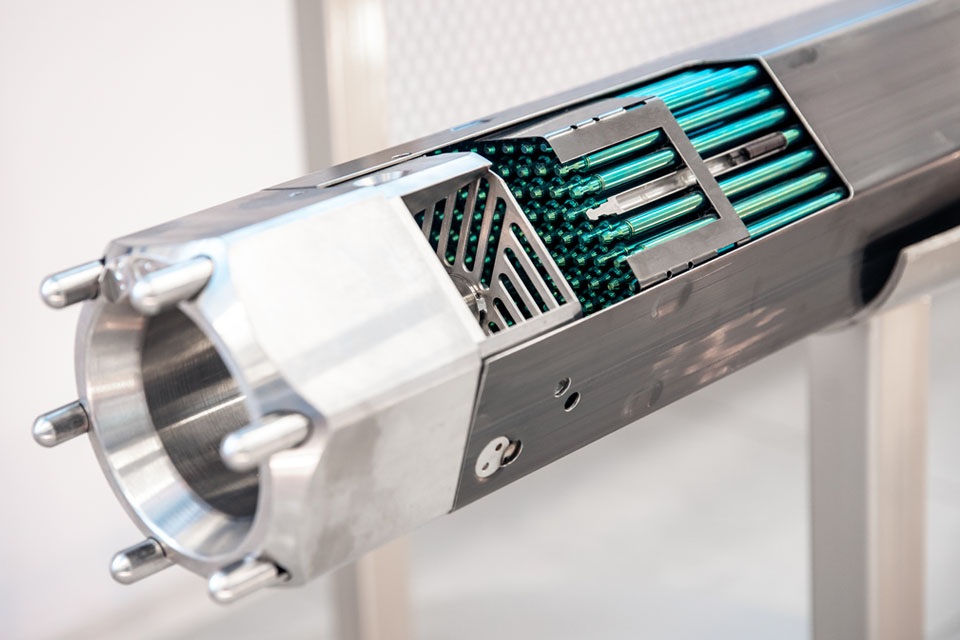Blog Published June 17, 2022 · 6 minute read
Why Downblending HEU is Vital to Keep US Advanced Nuclear on Target
Josh Freed, Alan Ahn, & Ryan Norman

Takeaways
While developing domestic enrichment capacity will be essential to fueling our advanced reactor fleet, downblending highly-enriched uranium (HEU) is urgently needed to produce the initial fuel loads for our first advanced reactor units and ensure we stay on schedule for commercializing advanced nuclear power. Although the current US HEU inventory is classified, the most recent declassified accounting in 2016 reveals a substantial amount of HEU available for potential downblending, of which only a modest portion would be required to produce the first fuel cores for our leading advanced reactor demonstrations. Considering the climate, commercial, geopolitical, and national security interests at stake, we must move forward with downblending as swiftly as possible.
In recent times, Russia has held a dominant position in the provision of nuclear fuel services to the global market—for certain fuels such as high-assay low-enriched uranium (HALEU), required for many advanced reactor designs, they currently have a monopoly over commercial supply. Thus, it is crucial that we quickly develop the capacity to produce and enrich nuclear fuel domestically so we can ensure reliable supply for both our existing fleet and emerging advanced reactor technologies.
Thankfully, there is momentum within the administration and Congress to get our reactors the fuel they need. Third Way recently outlined two bills that contain solutions to our present nuclear fuel challenges. The International Nuclear Energy Act of 2022, introduced by Senators Joe Manchin (D-WV) and James Risch (R-ID), authorizes $3.5B towards the build-out of domestic low-enriched uranium (LEU) and HALEU production infrastructure. The Fueling Our Nuclear Future Act, introduced by Senator John Barrasso (R-WY), specifically focuses on HALEU supply challenges and provides funding for downblending to assure timely supply for our vanguard advanced reactor deployments.
Staying on Schedule with Advanced Reactors
The Fueling Our Nuclear Future Act raises and addresses an essential point: although it is critically important that we develop domestic enrichment and nuclear fuel production capacity, DOE and industry acknowledge that this capacity will not be online quickly enough to produce the initial HALEU needed for the first Advanced Reactor Demonstration Program (ARDP) projects and other early advanced reactor deployments.
Without initial HALEU fuel supplies, we risk significant delays to the start dates of our first advanced reactors, thereby undermining the enormous bipartisan support and federal funding for advanced reactors in the US. For example, the bipartisan infrastructure bill made a historic commitment to advanced nuclear commercialization by the end of the decade, ensuring $3.2 billion of federal investment—to be matched dollar for dollar by the private sector—in the TerraPower and X-energy ARDP demonstrations. Further, Congress was clear in passing the law that the ARDP projects are to be completed by 2028. Any setbacks in the timelines of these demonstrations would compromise congressional mandates and the tremendous political and financial backing US advanced nuclear has received thus far.
Holdups in the first advanced reactor demonstrations could have negative impacts on the competitiveness of these technologies, as advanced reactor developers have sought to overcome conventional nuclear’s legacy of costly project delays. More directly, delays in the ARDP projects would likely result in significant workforce atrophy as prospective employees may move on to other employment. In the case of an extended interruption, the host communities of these demonstrations could suffer economic and employment disruptions if plants are not operational on schedule.
Moreover, delays in our first advanced reactor deployments only push back an urgently needed solution to reducing emissions and achieving robust decarbonization goals. The invasion of Ukraine has added even greater importance to meeting our ambitious schedules for commercializing advanced reactors, as our European partners and allies are urgently seeking energy alternatives to reduce their dependence on Russian natural gas.
Downblending to Produce HALEU
In addition to intensifying the urgency of deploying advanced nuclear, the conflict in Ukraine revealed a major fuel supply bottleneck: Russia is the world’s only commercial supplier of HALEU that many of our advanced reactors will need. With Russian HALEU now off the table, the only way to produce HALEU fast enough to meet the ARDP schedules is downblending highly-enriched uranium (HEU) into HALEU, as a one-time measure, to fuel the first cores for the ARDP reactors. DOE's National Nuclear Security Administration (NNSA) is responsible for managing the stockpile of excess HEU, and that inventory is classified. While DOE acknowledges that downblending could be a temporary solution to the HALEU challenge, some within NNSA have opposed providing any surplus HEU from their stockpile to produce HALEU. These voices have argued that excess HEU should be solely reserved for national security missions, the use of government downblending facilities is already oversubscribed, and the civil nuclear mission of DOE is not a strategic priority.
However, in 2016, the Obama administration declassified an accounting of the amount of HEU in the stockpile and the amount needed for the national security missions. In that document, it was noted that as of September 30, 2013, the total US HEU inventory was 585.6 metric tons, with 499.4 metric tons “for national security or non-national security programs including nuclear weapons, naval propulsion, nuclear energy, and science.” Of the remaining 86.2 metric tons, the federal government noted that “41.6 metric tons was available for potential down-blend to low enriched uranium.”
1 metric ton of HEU will produce approximately 4-5 metric tons of HALEU through downblending. Given that the first cores of the ARDP Pathway 1 demonstrations will require an estimated 25 metric tons of HALEU, roughly 6-7 metric tons of HEU would be needed for downblending. While we don’t know NNSA’s exact surplus HEU inventory today, the most recent declassified accounting shows that there was a significant amount of material available for downblending, of which only a modest amount would be required to produce initial HALEU fuel needs.
Conclusion
Not only would near-term HALEU needs require just a modest amount of HEU based on the latest assessments, downblending HEU would also entail a modest investment—between $150 to $200 million over the next few years to expand downblending capacity—compared to the massive political and financial commitments the federal government has made to advanced nuclear development in the last several years. A temporary downblending program is a necessary complement to the investments we’ve already made in advanced reactors, while accompanying efforts to develop domestic enrichment capabilities will likely enable options to replace the HEU used for downblending, if necessary. Of the nearly 42 metric tons of HEU that was previously available for downblending, it is likely that adequate stockpiles remain to produce the 25 metric tons of HALEU that is immediately needed to support our energy security and climate priorities. It is absolutely imperative that we secure both funding and the political will to rapidly move forward with downblending given all that we have at stake.



